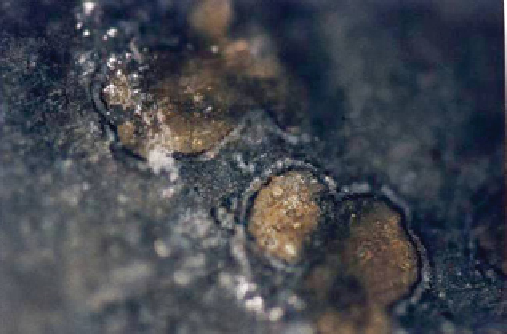Geology Reference
In-Depth Information
were designated as lithology C to distinguish this
material from the other lithologies. All plagioclase has
been converted to maskelynite, and other high-pressure
phases (ringwoodite and majorite) have been found in
veins.
One other olivine-phyric shergottite, LAR 06319,
has been recovered by ANSMET and has been
described by
Basu Sarbadhikari et al.
[2009] and
Peslier
et al.
[2010]. Although texturally and mineralogically
similar to the other olivine-phyric shergottites, and
thus considered close to its parental melt, LAR 06319
is unique in several ways. The minerals in LAR 06319
show a continuous oxidation trend with crystallization
over two full log units, from the reduced conditions
(QFM - 2.0) for early crystallizing phases to oxidizing
conditions (QFM + 0.3) for mesostasis phases [
Peslier
et al.,
2010]. LAR 06319 is also a member of the
“enriched” shergottites, according to Lu-Hf, Sm-Nd
isotopes and trace element data [
Shafer et al.
, 2010].
Thus, LAR 06319 has the dubious distinction of being
a “primitive” melt derived from an “enriched” mantle
source or from assimilated crust [
Usui et al.
, 2012].
LAR 06319 also has a distinct Mars launch age
(Figure 7.2) and is presumably from a different loca-
tion than EET A79001.
Figure 7.6.
Carbonate globules in ALH 84001. Orange interiors
are siderite, white rims are magnesite and dolomite, and black
bands contain magnetite. Globules are several hundred μm
across. Figure credit: Monica Grady.
breccia zones [
Treiman
, 1998;
Greenwood and McSween
,
2001;
Corrigan and Harvey
, 2004].
McKay et al.
[1996] presented the intriguing proposal
that ALH 84001 contains biochemical markers, biogenic
minerals, and microfossils (Figure 7.7), all supporting
extraterrestrial life. Summaries of arguments in support
of [e.g.,
Gibson et al.
, 2001;
Thomas-Keprta et al.
, 2009]
and against [e.g.,
McSween
, 1997;
Treiman
, 2003] this
idea have been published in the scientific and popular lit-
erature. Polycyclic aromatic hydrocarbons (PAHs) found
in ALH 84001 do not require a biologic source and play
no significant role in biochemistry [
Zolotov and Shock
,
1999] but might have formed through diagenesis of
decomposed biologic matter [
Clement and Zare
, 1996].
The PAHs in ALH 84001 represent only a tiny fraction of
the organic matter in this meteorite, whose bulk carbon
isotopic composition indicates terrestrial contamination
[
Bada et al.
, 1998;
Jull
, 1998;
Becker et al.
, 1999].
Nanophase magnetite grains found in the carbonates
were described as morphologically similar to those pro-
duced by terrestrial magnetotactic bacteria [
McKay et al.
,
1996;
Thomas-Keprta et al.
, 2009]. However, magnetite
whiskers and platelets [
Bradley et al.
, 1996] and epitaxial
growth of magnetites on carbonate [
Bradley et al.
, 1998]
are inconsistent with a biologic origin, and their occur-
rence with periclase in carbonate voids suggests formation
by carbonate decomposition during impact heating
[
Barber and Scott
, 2002;
Brearley
, 2003]. Elongated, seg-
mented forms in carbonates were suggested to be micro-
fossils [
McKay et al.
, 1996]; this claim was later partially
retracted when similar features were shown to be arti-
facts of sample preparation [Bradley et al., 1997; McKay
et al., 1997]. The biological community was very unsup-
portive, given that these forms are smaller than most
viruses, with internal volumes too tiny to hold enough
7.5. ORTHOPYROXENITE: ALH 84001
Gram for gram, Allan Hills 84001 may be the most
intensely studied rock in history. As the oldest of the mar-
tian meteorites, it represents the ancient Noachian crust.
It also contains the highest abundance of preterrestrial
secondary minerals found among the martian meteorites
and thus has witnessed the vast majority of that planet's
history. It is also perhaps the most publicly recognizable
of the martian meteorites, given claims that its secondary
minerals reveal a history that includes biological activity.
Allan Hills 84001 is an orthopyroxene cumulate (1.93
kg) containing minor olivine, chromite, carbonate, sulfide,
phosphate, augite, and glass (Plate 69). Originally misclas-
sified as a diogenite, it was not recognized as a martian
sample until a decade after its recovery [
Mittlefehldt
,
1994], based primarily on its oxygen isotopic composition.
Geochemical analyses of ALH 84001 [
Warren and
Kallemeyn
, 1996;
Wadhwa and Crozaz
, 1998] are consis-
tent with origin as a magmatic cumulate. The crystallization
age of 4.09 Ga [
Lapen et al.
, 2010] identifies it as the only
available meteoritic sample, other than NWA 7034, of the
ancient martian crust. The age of secondary carbonate
mineralization has been dated at 3.90 Ga [
Borg et al.
,
1999]. The meteorite was heavily shocked, forming brecci-
ated granular bands and feldspathic and silica glasses.
Multiple shock events bracket the precipitation of car-
bonate globules and pancakes (Figure 7.6) within the

